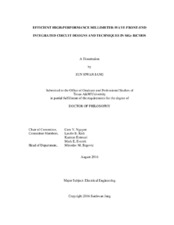| dc.description.abstract | This dissertation presents various “efficient” design techniques for mm-wave front-end integrated circuits in regards to dc power, bandwidth, and chip size. The ideas, while suitable for different CMOS/BiCMOS processes, were implemented using a 0.18-μm SiGe BiCMOS process. The proposed techniques are validated through the actual implementations of several building blocks constituting two different front-end sections: a V-band OOK/pulse transceiver front-end and a concurrent K-/V-band receiver front-end, where K-band ranges from 18 to 27 GHz and V-band from 40 to 75 GHz.
As one of the constituent components in the V-band pulse transmitter, a 60-GHz active OOK/pulse modulator has been designed with an emphasis on the enhancement in the ON/OFF isolation. Having a decent gain (higher than 10 dB), the designed modulator can also be used as a driver stage, which can save the chip area and possibly the dc power consumption compared to the combination of a switch-based passive modulator and a drive amplifier. For the receiver front-end, a wideband V-band low-noise amplifier (LNA) has been designed. Employing a wideband gain shaping technique through two T-type inter-stage matching networks, the designed LNA features very high gain-bandwidth product compared to the conventional gain-staggered wideband amplifier designs for a given dc power consumption.
For the concurrent K-/V-band receiver front-end, a low-noise and variable gain stages have been designed. As the first component of the receiver chain, a concurrent dual-band LNA has been designed within a similar footprint required for a single-band amplifier operating either at K- or V-band. The most significant direct intermodulation (IM) product and harmonics are suppressed by a simple rejection network between the input and cascode devices of the 1st stage. This network also plays a crucial role in achieving dual-band input matching through Miller effect. For amplitude control purposes in the RF stage, a variable gain amplifier (VGA) operating concurrently at K- and V-bands has been developed starting from a wideband amplifier design. By replacing the inductors in the wideband design with the transformer-coupled resonators (TCRs), the critical direct IM products can be suppressed without increasing the active chip area. Gain tuning is achieved by conventional current steering, but a new technique is applied to reduce phase variation in the course of gain tuning process, which is one of the most critical concerns, especially in phased array systems. | en |


